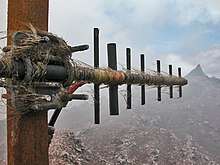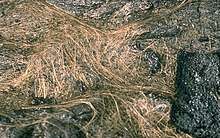Pele's hair
Pele's hair (closest Hawaiian translation: "huluhulu o pele") is a form of lava. It is named after Pele, the Hawaiian goddess of volcanoes. It can be defined as volcanic glass fibers or thin strands of volcanic glass.[1] The strands are formed through the stretching of molten basaltic glass from lava, usually from lava fountains, lava cascades, and vigorous lava flows.
Wind often carries the light fibers high into the air and to places several kilometers away from the vent. It is common to find strands of Pele's hair on high places like treetops, radio antennas, and electric poles.
Pele's hair does not occur solely in Hawaii. It can be found near other volcanoes around the world, for example in Nicaragua (Masaya), Italy (Etna), Ethiopia (Erta’ Ale), and Iceland, where it is known as "nornahár" ("witches' hair").[2] It is usually found in gaps in the ground, mostly near vents, skylights, ocean entry, or in corners where Pele's hair can accumulate.
It is not recommended to touch Pele's hair, because it is very brittle and very sharp, and small broken pieces can enter the skin. Gloves should be worn while examining it.
Pele's hair may occur along with Pele's tears.[2] They tell volcanologists information about the eruption, such as the temperatures and the magma's path to the surface. Plagioclase starts to crystallize from the magma of Pele's hair at around 1,160 °C.[3] Also, the shape of the tears can provide an indication of the velocity of the eruption, and the bubbles of gas and particles trapped within the tears can provide information about the composition of the magma chamber.
Formation


The strands are created when molten lava is ejected into the air and form tiny droplets, which elongate perfectly straight. It usually forms in lava fountains, lava cascades, and vigorous lava flows.[2]
Features
Pele's hair has a golden yellow color and looks like human hair or dry straw. In sunlight, it has a shimmering gold color. Length varies considerably, but is typically 5 to 15 cm, and can be up to 2 m.[4] Hair diameter ranges from about 1 to 300 µm (0.001 to 0.3 mm), and therefore weight is accordingly low.
Applications
Mineral wool (also called stone wool or rock wool) is commonly used as a non-combustible, durable, dimensionally stable, UV stable, hydrophobic, vapor-permeable building insulation material for residential, commercial, and high rise buildings. The process of manufacturing this material uses a similar principle to the formation of Pele's hair: melting rock and recycled slag from steel manufacturing combined with high-pressure air currents. A hydrophilic version of this material can be used as a low water usage, high yield, soil substitute for hydroponic agriculture.
Traditional beliefs
Pele is known as the goddess of fire, lightning, wind, dance and volcanoes. The legends that tell how Pele first came to the Hawaiian Islands have many versions, but it is believed that Pele's spirit lives in the crater of the Kilauea volcano, on the island of Hawaii. Pele appears as a spirit in many forms, and she is considered a negative harbinger. Most native Hawaiians state that they have had at least one encounter with her.
Hawaiians traditionally believe that they must live in harmony with all natural things, and that Pele will curse with bad luck people who take lava rock, sand, seashells, or other natural parts of the islands away with them, until they return these items to their rightful place. Additionally, federal law prohibits taking anything out of a national park. Each year large quantities of such objects are mailed back to Hawaii by people who believe they have received such bad luck.[5][6]
See also
- Pele's tears
- Limu o Pele (Pele's seaweed)
- Mineral wool
- Glass wool
- Pele's Curse
References
- Shimozuru, Daisuke (1994). "Physical parameters governing the formation of Pele's hair and tears". Bulletin of Volcanology. 56 (3): 217–219. doi:10.1007/BF00279606.
- Duffield, W. A.; Gibson Jr., E. K.; Heiken, G. H. (1977). "Some characteristics of Pele's hair" (PDF). Journal of Research of the U. S. Geological Survey. 5 (1): 93–101.
- Katsura, Takashi (1967). "Pele's hair as a liquid of Hawaiian tholeiitic basalts" (PDF). Geochemical Journal. 1 (4): 157–168. doi:10.2343/geochemj.1.157.
- Herzog, G. F; et al. (2009). "Isotopic and elemental abundances of copper and zinc in lunar samples, Zagami, Pele's hairs, and a terrestrial basalt". Geochimica et Cosmochimica Acta. 73 (19): 5884–5904. doi:10.1016/j.gca.2009.05.067.
- "Pele, Hawaii Goddess of Fire: Hawaiian Legend ⋆ Mythical Realm". 22 August 2016.
- Moon, Grandmother. "Hawai'ian Volcano Goddess, Madame Pele".
- Moune, Séverine; Faure, François; Gauthier, Pierre-j. (2007) Pele's hairs and tears: Natural probe of volcanic plume. Elsevier, Journal of Volcanology and Geothermal Research. France, p. 244-253
- M. Potuzak, M., Dingwell, D.B., Nichols, A.R.L. (2006) Hyperquenched Subaerial Pele’s Hair Glasses from Kilauea Volcano, Hawaii European Geosciences Union, v. 8
- Piccardi, L. and Masse, W. B. (2007) Myth and Geology Geological Society, London, Special Publications, 273, 1-7. The Geological Society of London, 2007
- Zimanowki, B., Buttner, R. Lorenz, V., Hafele, H-G. (1997) Fragmentation of Basaltic Melt in the Course of Explosive Volcanism. Journal of Geophysical Research, Vol. 102, No. B1, Pages 803-814
- Villmant, B.; Salaün, A. and Staudacher, T. (2009) Evidence for a Homogeneous Primary Magma at Piton De La Fournaise (La Réunion): A Geochemical Study of Matrix Glass, Melt Inclusions and Pélé's Hairs of the 1998–2008 Eruptive Activity. Journal of Volcanology and Geothermal Research, v. 184, p. 79-92
Bibliography
- Gill, Robin. Igneous Rocks and Processes: A Practical Guide. Hoboken, N.J.: Wiley-Blackwell, 2010.
- Lopes, Rosaly. The Volcano Adventure Guide. Cambridge, UK: Cambridge University Press, 2005.
- MacDonald, Gordon Andrew; Abbott, Agatin Townsend; and Peterson, Frank L. Volcanoes in the Sea: The Geology of Hawaii. Honolulu: University of Hawaii Press, 1983.
- Morey, Kathy. Hawaii Trails: Walks, Strolls, and Treks on the Big Island. Berkeley, Calif.: Wilderness Press, 2006.
- Nimmo, Harry. Pele, Volcano Goddess of Hawai'i: A History. Jefferson, N.C.: McFarland & Co., 2011.
External links
| Wikimedia Commons has media related to Pele's hairs. |


